#ACID SPECIES
Explore tagged Tumblr posts
Text


There's actual oceans on Cybertron. Rodion is a port.
#I've seen this panel a million times and it only just registered#I knew they had clouds and acid rain and Riptide's a boat alt and there was a Simanzi forced flood idk what I was expecting lol#Somehow in my head all their seas are rust deserts and their main liquid is oil#maybe fish can live in it#put some inside and watch them turn into an invasive species#mtmte#idw transformers#transformers#maccadam
405 notes
·
View notes
Text

art for my partner's birthday today with our sonas!!!
#managed to get time to draw this during this hellish final week for my assignment . thank goodness#furry#dragon#ambiguous species#my art#his fursona is called Acid btw and he's awesome
22 notes
·
View notes
Text
Decided I will be posting more of my art on here, so have the Acidic Trapmaw!
As usual feel free to make ocs with my species, so long as you give proper credit!

#httyd#how to train your dragon#httyd rtte#rtte#httyd dragons#httyd fan species#httyd fan dragon#acidic trapmaw#acidic trapmaw httyd#acidic trapmaw rtte#acidic trapmaw how to train your dragon#the list grows evermore
35 notes
·
View notes
Photo
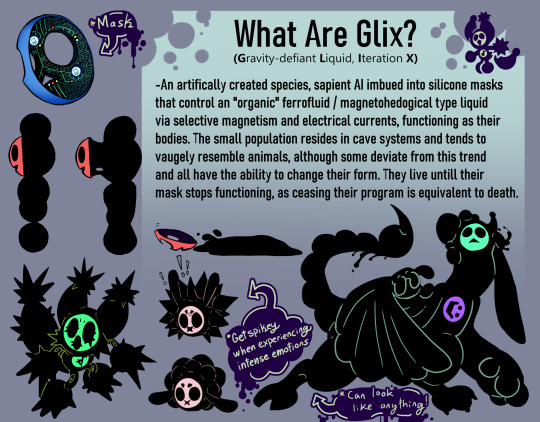
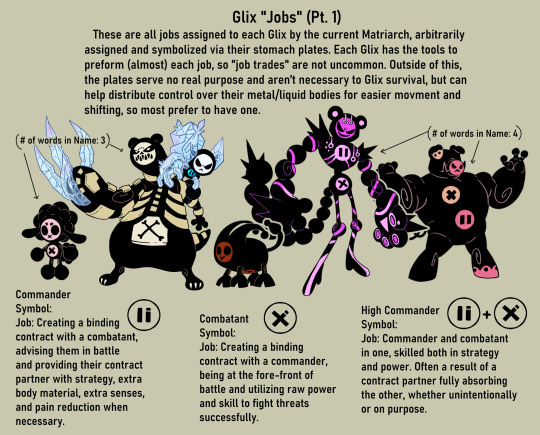

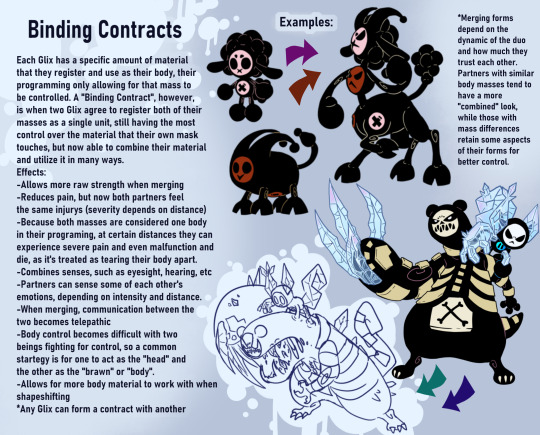
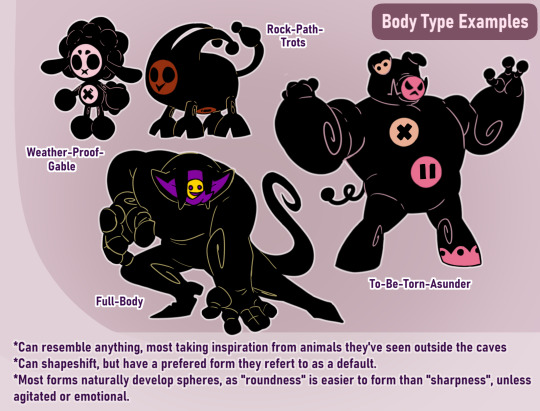
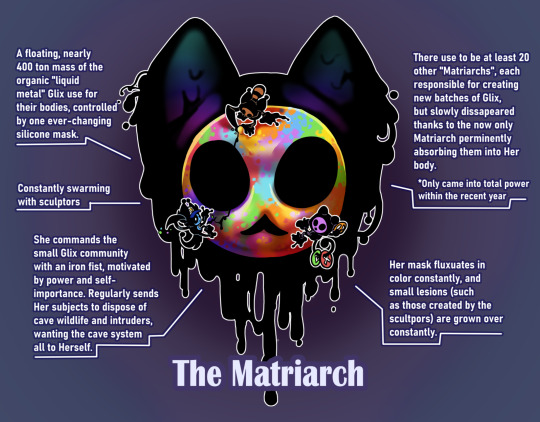
[ID: A series of digital artworks describing an original species named Glix in detail. The species is shown to be ferro-fluid based, with black, goopy bodies taking different shapes while accented by more colorful, yet equally simple masks. The first few parts covers their physical abilities, as it’s explained that the masks themselves are sentient and the ferrofluid bodies are controlled via magnetism and electric currents exuded by the masks. Because of them, they are shown to be able to change shape and even grow spikes when stressed, similar to how magnetic fluid acts in real life. Other parts elaborate on the roles they take in their underground living quarters, as the small population is forced to follow orders from the giant floating Glix head known as the Matriarch. Jobs include scout, commander, combatant, high commander, and translator, and their stomach plate symbols are shown to coincide with their roles. Some final information details how two Glix can form a contract, where they’re able to share ferrofluid mass and become bigger and stronger from it. End ID]
Glix, ferrofluid / magnetohedogical-based creatures that live underground and can take a variety of different shapes ... plus so much more!
(Open species, feel free to make one :] )
#glix#open species#original species#my art#ocs#acidnote#acid-note#sorry for all the lore dump i just love these little beasts
94 notes
·
View notes
Text
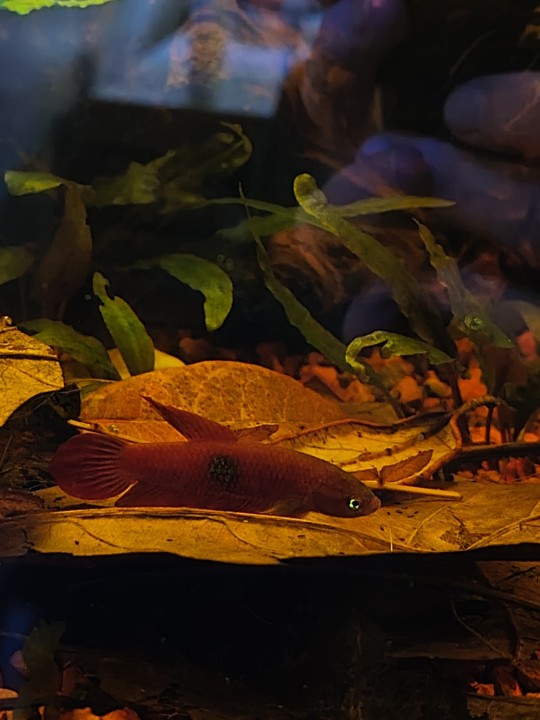

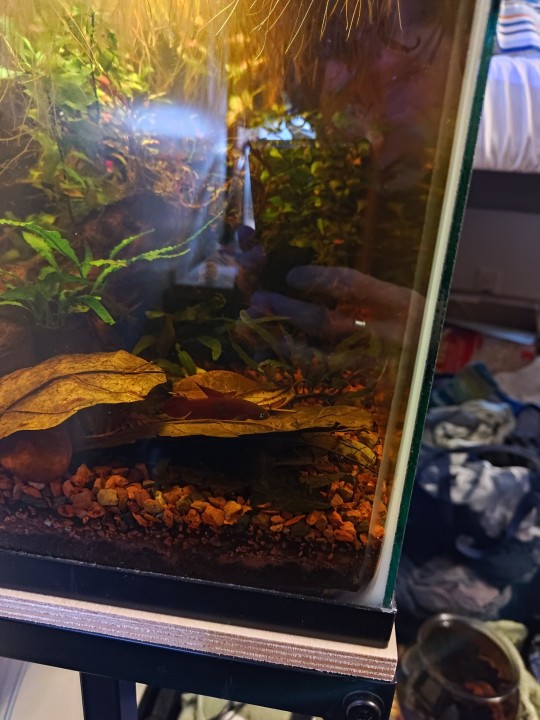
computer, enhance
#darcy#betta brownorum#betta fish#bettablr#sigh i fear he is ill unfortunately#i am working on a 5 gal for the shrimp because i think that the water hardness ive kept up for them is doing it#and its a neutral ph for them too#his species wants the water pretty much as soft and acidic as possible#the new tank is extremely yucky rn tho lol
46 notes
·
View notes
Text
This is a silly one... I did a sketch that looked vaguely like an anteater monster and then uhh. Turned it into a "what if there was a xenomorph anteater hybrid."
Entirely because the idea of an anteater having a tiny set of extra jaws on the end of its tongue cracked me up.
#my art#xenomorph#i have anteaters on the brain apparently don't judge me#they're SO WEIRD giant anteaters look like several different species accidentally jumbled into one skeleton. I love them.#they don't produce their own stomach acid!
4 notes
·
View notes
Text
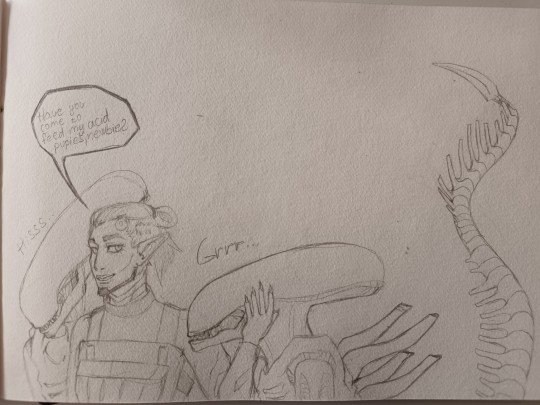
Acid puppies are the best... No one will prove me otherwise! Jsjxnnsjjs
#original character#art#traditional sketch#xenomorph#xenomorph oc#xeno#alien species#alien movie#acid puppies are THE BEST!#oc artwork#art wip#artwork#weyland yutani
8 notes
·
View notes
Text
ok does anyone have any good sites for finding names bc this isnt one of them

#speci speaks#the phrase 'If you don't know Banjo is a unique musical instrument many people love to play' is having like an acidic effect on my body#i cant explain it. it just is#what the hell is a gen z friendly name
3 notes
·
View notes
Text
I think someone put the brain of a mouse or maybe a squirrel inside my head at some point because all winter I was like “I crave nuts and seeds” and now that it’s getting warmer and brighter out my brain keeps going “it’s fruit time”
Like, modern transportation has made it possible to move many fruits all over the world (in theory) all the time! But the primal early plesiadapiform part of my brain is like “you must eat what is available this season”
#I was going to go with euarchonta or plesiadapiform brain but I think the early members of both of those groups were from a tropical#ecosystem. if I’m wrong though and either are from more seasonal environments I could change what I used#actually. wait. plesiadapis is from the late Paleocene. yes. but tropical plants have reproductive cycles too#do they generally vary by season or are they just doing it all at their own pace by species#I am from a very cold seasonal climate that gets hot af in summer but is pretty cold for a good five-ish months#not all equally cold#it’s bad for our environment if it doesn’t get cold as balls for a bit every winter#and we didn’t really get that this winter. but that’s not my point!#I mean to say I can’t remember how it works in tropical environments#if the plants just time their reproduction whenever in the year or if there are seasons for most plants at the same time#does that make sense? I’m using the primate-like-mammal. if it’s wrong then whatever#fuck it we ball#maybe I should have gone with a group further back in time but I couldn’t find climate info easily about things that far back and fuzzier#i am not the most familiar with primate evolution. especially early evolution of the group. I’m open to learning more#i just tend to fixate on certain other things like early mammals and horse and cat evolution#paleontology#emma posts#I like juice all year though#one day I want to try many varieties of fruits that I cannot access easily where I live because they can’t be shipped here#or they just aren’t as popular a variety on an industrial scale#maybe one day i will have a big greenhouse and i will be able to grow the banana varieties I want to try#I can see why some plant varieties aren’t grown on a large scale. some of these bitches are SUPPOSED to be able to grow in zone four but#they refuse to work with me! blueberries make sense. the soil here is nowhere near acidic enough and they would need to be in a pot or#whatever. ya know? but some plants just won’t! or I get them and then the weather here which would NORMALLY work is different that season
3 notes
·
View notes
Text
Do you think there's an alien species that does its enzyme based digestion process externally, like spiders do-- inject the venom, gooify the prey, slurp up the nutrislurry-- and then they meet humans and are like what do you mean you just carry an acid with a PH of one inside your body.
#the cosmic horror of being known#aliens#human biology#first contact#what do you mean most species are full of acid on your planet#you drink it too oh god oh god
2 notes
·
View notes
Text
SciTech Chronicles. . . . . . . . .Jun 4th, 2025
#southeast#plumes#“atmospheric waves”#westward#CL1#code-deployable#biomimetic#neuromorphic#microbiome#urocanase#“cis-urocanic acid”#“Staphylococcus epidermidis”#eDNA#intact#species#pathogens#personal#“chimeric antigen receptor”#colorectal#“T Cells”
0 notes
Text
Mitochondrial Dysfunction in Beckers Muscular Dystrophy

Introduction
Beckers Muscular Dystrophy (BMD) is a genetic neuromuscular disorder caused by mutations in the DMD gene, leading to defective dystrophin production. While dystrophin primarily serves as a structural protein, emerging evidence indicates its role in mitochondrial function and cellular metabolism. This article explores mitochondrial dysfunction in BMD, focusing on bioenergetics, oxidative stress, mitochondrial dynamics, and metabolic consequences.
Bioenergetic Impairment
Mitochondria are the primary energy-producing organelles, generating adenosine triphosphate (ATP) through oxidative phosphorylation (OXPHOS). In BMD, mitochondrial bioenergetics are disrupted due to reduced dystrophin-associated glycoprotein complex (DGC) stability, affecting intracellular signaling and energy metabolism. Studies show that muscle fibers from BMD patients exhibit reduced ATP production, mitochondrial membrane potential (ΔΨm) depolarization, and decreased respiratory chain efficiency. Impaired complex I and complex IV activities have been reported, contributing to decreased oxidative phosphorylation and subsequent muscle weakness.
Oxidative Stress and ROS Accumulation
Mitochondria are a significant source of reactive oxygen species (ROS), which play dual roles as signaling molecules and contributors to oxidative damage. In BMD, excessive ROS production due to dysfunctional electron transport chain (ETC) exacerbates oxidative stress. Studies have demonstrated elevated lipid peroxidation, increased protein carbonylation, and mitochondrial DNA (mtDNA) damage in BMD-affected muscles. Reduced expression of key antioxidant enzymes, such as superoxide dismutase (SOD) and glutathione peroxidase (GPx), further impairs the ability to counteract oxidative damage. The resulting oxidative burden contributes to muscle fiber degeneration, chronic inflammation, and apoptosis.
Mitochondrial Dynamics: Fission and Fusion Imbalance
Mitochondria continuously undergo fission and fusion processes to maintain cellular homeostasis. These dynamics are critical for mitochondrial quality control, ensuring the removal of damaged mitochondria via mitophagy. In BMD, an imbalance between fission and fusion leads to mitochondrial fragmentation and defective turnover. Key regulators such as dynamin-related protein 1 (DRP1) and mitofusin-2 (MFN2) exhibit altered expression, resulting in increased mitochondrial fission and reduced fusion. This dysregulation impairs mitochondrial network integrity, contributing to decreased ATP production and enhanced susceptibility to apoptosis.
Calcium Homeostasis and Mitochondrial Dysfunction
Dystrophin deficiency in BMD disrupts sarcolemmal stability, leading to aberrant calcium (Ca²⁺) handling. Elevated intracellular Ca²⁺ levels induce mitochondrial Ca²⁺ overload, impairing bioenergetic function and promoting mitochondrial permeability transition pore (mPTP) opening. mPTP dysregulation results in mitochondrial swelling, cytochrome c release, and apoptotic cascade activation. Additionally, excessive mitochondrial Ca²⁺ uptake alters ATP synthesis efficiency, exacerbating muscle fiber necrosis and degeneration.
Metabolic Alterations and Energetic Deficits
Skeletal muscle metabolism in BMD is characterized by a shift from oxidative to glycolytic energy production. Defective mitochondrial respiration forces muscle fibers to rely on glycolysis for ATP generation, leading to increased lactate accumulation and metabolic acidosis. This metabolic shift results in early fatigue, reduced endurance, and inefficient energy utilization. Transcriptomic analyses have identified downregulation of genes involved in fatty acid oxidation and tricarboxylic acid (TCA) cycle activity, further confirming the metabolic shift towards glycolysis. Such metabolic alterations compromise muscle function and regeneration capacity, contributing to disease progression.
Mitochondrial Quality Control and Mitophagy Defects
Mitophagy, a selective form of autophagy responsible for degrading damaged mitochondria, is impaired in BMD. The PINK1/Parkin pathway, essential for mitochondrial quality control, is downregulated in dystrophic muscle, leading to the accumulation of dysfunctional mitochondria. Defective mitophagy contributes to mitochondrial swelling, increased oxidative stress, and cellular energy deficits. Additionally, impaired mitophagy reduces the capacity for mitochondrial biogenesis, further exacerbating mitochondrial dysfunction and muscle pathology.
Conclusion
Mitochondrial dysfunction in BMD arises from bioenergetic impairments, oxidative stress, disrupted mitochondrial dynamics, altered Ca²⁺ homeostasis, metabolic deficits, and defective mitophagy. These abnormalities collectively contribute to muscle degeneration and disease progression. Understanding these mitochondrial defects provides valuable insights into the pathophysiology of BMD, emphasizing the need for targeted researc
h to mitigate mitochondrial dysfunction and improve muscle health in affected individuals.
#Beckers Muscular Dystrophy#Mitochondrial dysfunction in BMD#Oxidative stress in muscular dystrophy#Mitochondrial bioenergetics in BMD#ATP production in muscle disease#Reactive oxygen species (ROS) in BMD#Electron transport chain dysfunction#Mitochondrial DNA damage in BMD#Calcium homeostasis in muscular dystrophy#Mitochondrial fission and fusion imbalance#Mitophagy defects in BMD#Muscle fiber degeneration in BMD#Glycolytic metabolism in muscular dystrophy#Mitochondrial membrane potential disruption#Sarcolemmal instability in BMD#Superoxide dismutase (SOD) in muscle health#Mitochondrial permeability transition pore (mPTP)#Fatty acid oxidation in muscle disease#Dystrophin-associated glycoprotein complex (DGC)#Metabolic deficits in Beckers muscular dystrophy
0 notes
Photo





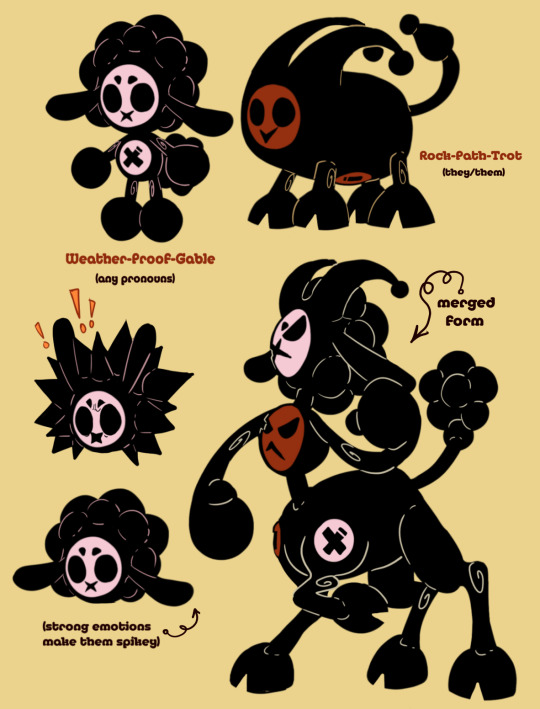


[ID: A series of digital drawings featuring a variety of ferro-fluid based creatures, all with charcoal-black bodies resembling animals and faces defined by simplistic masks. Many of them also sport stomach plates, round like their masks and with symbols etched on them. Their species are labeled as “Glix”, and include characters such as a cat shaped one named Acid-Note, a mouse one called Lonely-Song, a rabbit named Spot-Minot, Solo-Chip the wolf, The-Vibrant-Neonic-Plus the ocelot, A-Combat-Skeleton the bear, Brilliant-Luminant-Blue the squirrel, Rock-Path-Trot the goat, Weather-Proof-Gable the sheep, and more that are unnamed, such as a pig and a lizard. The images show them in different poses and mainly serve as simple visual references. End ID]
Character art featuring my Glix species from a few months back!
#silly beasts I love them#oc#my art#glix#acid-note#acidnote#original species#theyre an open species btw you can go ham feel free to ask questions#Lonely-Song#Spot-Minot#Solo-Chip#The-Vibrant-Neonic-Plus#A-Combat-Skeleton#Brilliant-Luminant-Blue#Rock-Path-Trot#Weather-Proof-Gable#gable is kinda my fav design wise cant go wrong with ferrofluid sheep
34 notes
·
View notes
Text
youtube
#WO₃₋ₓ@Ferrocene-Folic Acid#photothermal therapy#chemodynamic therapy#reactive oxygen species#Fenton reaction#cancer nanomedicine#targeted drug delivery#tumor microenvironment#immunogenic cell death#nanoplatform#folate receptor targeting#oxidative stress#tumor ablation#ferrocenyl compounds#nanoparticle-mediated therapy#oxygen-deficient tungsten oxide#cancer immunotherapy#ROS generation#synergistic therapy#advanced oncology treatments.#Youtube
1 note
·
View note
Text
#2712 - Sedum album - White Stonecrop


A mostly prostrate herb from temperate Europe, N. Africa, and W. Asia. Naturalised in NZ since 1959. Usually grows in crevices or free-draining rocky soil.
As the binomial suggests, the flowers are white, but may be pink-tinged if conditions are too dry. Sedum album is able to switch between C3 carbon fixation and crassulacean acid metabolism (CAM) depending on the availability of water - the latter reduces the amount of water lost through the stomata, because they only need to open at night.
Alexandra, Aotearoa New Zealand
0 notes
Text
Ancient redwoods recover from fire by sprouting 1000-year-old buds

Article | Paywall free
When lightning ignited fires around California’s Big Basin Redwoods State Park north of Santa Cruz in August 2020, the blaze spread quickly. Redwoods naturally resist burning, but this time flames shot through the canopies of 100-meter-tall trees, incinerating the needles. “It was shocking,” says Drew Peltier, a tree ecophysiologist at Northern Arizona University. “It really seemed like most of the trees were going to die.”
Yet many of them lived. In a paper published yesterday in Nature Plants, Peltier and his colleagues help explain why: The charred survivors, despite being defoliated [aka losing all their needles], mobilized long-held energy reserves—sugars that had been made from sunlight decades earlier—and poured them into buds that had been lying dormant under the bark for centuries.
“This is one of those papers that challenges our previous knowledge on tree growth,” says Adrian Rocha, an ecosystem ecologist at the University of Notre Dame. “It is amazing to learn that carbon taken up decades ago can be used to sustain its growth into the future.” The findings suggest redwoods have the tools to cope with catastrophic fires driven by climate change, Rocha says. Still, it’s unclear whether the trees could withstand the regular infernos that might occur under a warmer climate regime.
Mild fires strike coastal redwood forests about every decade. The giant trees resist burning thanks to the bark, up to about 30 centimeters thick at the base, which contains tannic acids that retard flames. Their branches and needles are normally beyond the reach of flames that consume vegetation on the ground. But the fire in 2020 was so intense that even the uppermost branches of many trees burned and their ability to photosynthesize went up in smoke along with their pine needles.
Trees photosynthesize to create sugars and other carbohydrates, which provide the energy they need to grow and repair tissue. Trees do store some of this energy, which they can call on during a drought or after a fire. Still, scientists weren’t sure these reserves would prove enough for the burned trees of Big Basin.
Visiting the forest a few months after the fire, Peltier and his colleagues found fresh growth emerging from blackened trunks. They knew that shorter lived trees can store sugars for several years. Because redwoods can live for more than 2000 years, the researchers wondered whether the trees were drawing on much older energy reserves to grow the sprouts.
Average age is only part of the story. The mix of carbohydrates also contained some carbon that was much older. The way trees store their sugar is like refueling a car, Peltier says. Most of the gasoline was added recently, but the tank never runs completely dry and so a few molecules from the very first fill-up remain. Based on the age and mass of the trees and their normal rate of photosynthesis, Peltier calculated that the redwoods were calling on carbohydrates photosynthesized nearly 6 decades ago—several hundred kilograms’ worth—to help the sprouts grow. “They allow these trees to be really fire-resilient because they have this big pool of old reserves to draw on,” Peltier says.
It's not just the energy reserves that are old. The sprouts were emerging from buds that began forming centuries ago. Redwoods and other tree species create budlike tissue that remains under the bark. Scientists can trace the paths of these buds, like a worm burrowing outward. In samples taken from a large redwood that had fallen after the fire, Peltier and colleagues found that many of the buds, some of which had sprouted, extended back as much as 1000 years. “That was really surprising for me,” Peltier says. “As far as I know, these are the oldest ones that have been documented.”
... “The fact that the reserves used are so old indicates that they took a long time to build up,” says Susan Trumbore, a radiocarbon expert at the Max Planck Institute for Biogeochemistry. “Redwoods are majestic organisms. One cannot help rooting for those resprouts to keep them alive in decades to come.”
-via Science, December 1, 2023
#redwoods#california#wildfire#climate change#extreme heat#natural disasters#botany#plant biology#photosynthesis#santa cruz#hopepunk#sustainability#climate hope#united states#good news#hope
13K notes
·
View notes